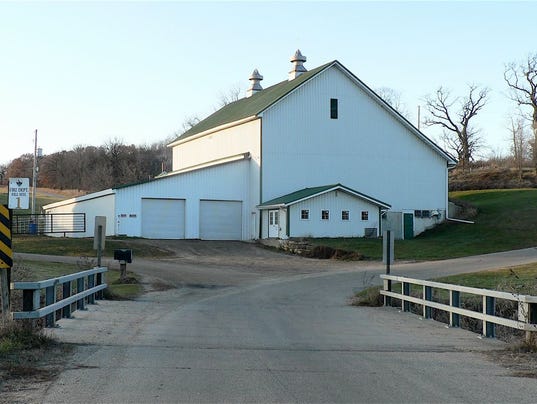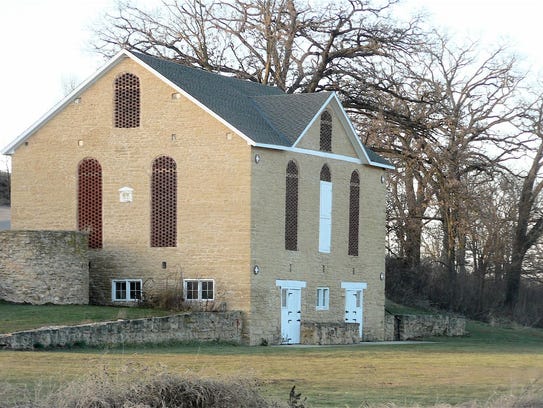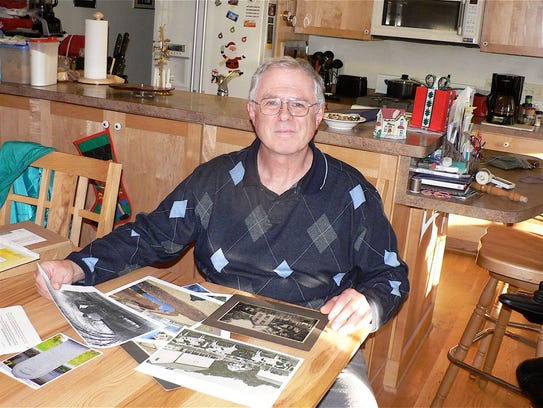 Silvan Blum is a cheesemaker at Deppler Cheese Factory near Monroe — he’s also a bit of a historian on the famed cheese industry in Green county. He was the one that guided me to the marker commemorating the site of the first commercial cheese factory established by Nic Gerber in 1868 just west of New Glarus.
Silvan Blum is a cheesemaker at Deppler Cheese Factory near Monroe — he’s also a bit of a historian on the famed cheese industry in Green county. He was the one that guided me to the marker commemorating the site of the first commercial cheese factory established by Nic Gerber in 1868 just west of New Glarus.
He also invited me to visit him again and see the stone barn on his farm that was built in 1861 and since restored. I never accepted his invitation to visit, primarily because I knew he began work at the cheese factory at 1 a.m. and I didn’t want to disturb him if he was sleeping during the day.
This past November 5th or so, I noted the obituary of Dr. Fred Blum, a well-known Madison ophthalmologist who died at the age of 90. The obituary went on to detail how Dr. Blum and his family moved from Madison to a farm west of Monticello that had been settled by his Swiss emigrant ancestors in 1848.
The farm had a long documented history: from its homesteaded beginning 1848 with only a log cabin on Hefty Creek to becoming one of the first farms in the area to switch from wheat to dairying, build a 44 cow stone barn and was considered one of the county’s most progressive operations.
The Blums began raising horses and later added beef cattle. During the 1960’s their beef bulls topped the UW-Plattevile bull testing station for rate of gain. It was in the 1970’s that a dairy herd was reestablished on the farm.
I also noted that one of Dr. Blum’s children was Silvan Blum, the cheesemaker, thus prompting me to call him and hear the history of what is now-known as Heft-Blum Homestead Farm.
It turned out to be a most opportune time to visit with Silvan as he had fallen on Thanksgiving day and torn ligaments in his right leg and was unable to work, thus had some time to tell me more about the farm.
80 acres
This farm was homesteaded in 1848 with 80 acres. However, by 1870, the farm had grown to 600 acres, Blum began. The owner, Fridolin Hefty planned to give each of his sons 160 acres. It turned out that only one son,Tom, wanted to farm and he was the one who built most of the farm buildings. His son, Fred Hefty, followed as the farmer.
A building boom
 A granary was built in 1851. Interestingly, a part of that building remains today but has been incorporated into a more modern building. The stone barn was constructed in 1861 and built into a steep hill. The big white barn — a Swiss-design forebay bank barn — went up in 1880 and the house was built about the same time.
A granary was built in 1851. Interestingly, a part of that building remains today but has been incorporated into a more modern building. The stone barn was constructed in 1861 and built into a steep hill. The big white barn — a Swiss-design forebay bank barn — went up in 1880 and the house was built about the same time.
It wasn’t long before Adam Blumer, a cheesemaker from Switzerland moved to a farm next door and began making cheese in his house. “It’s possible that the milk from the Hefty farm went next door to the Blumer farm to be made into cheese,” Silvan says.
A cheese factory
He also points out that the 1860’s and 1870’s saw a building boom on the farm as the stone barn, carriage shed, white barn, house and cheese factory all went up. By 1881 there were three farms in the area milking cows with the Hefty farm being far the biggest with 75 cows. This swayed the decision to build a cheese factory near the most cows.
The factory was built just behind the big white barn and as was common, it was a two story wooden structure with living quarters on the top floor and cheesemaking area on the ground floor. It had one cheese vat, and a processing room and storage area.
Big processors came
As happened throughout Green county, as farms got bigger and produced more milk, larger trucks could move milk further distances in bigger amounts, hence bigger cheese factories were needed to handle the milk.
Blum points out that another factor in the demise of the small cheese factory was the arrival of the big milk processors. In 1910 the Helvetia Milk Condensing Company was being built near the railroad tracks in New Glarus. The company, later to become The Pet Milk Company, with plants in Monticello and Belleville needing large amounts of milk for their evaporated milk product. It followed that the small, very local operations closed, as did the Hefty factory in 1911.
The formerly active but now-empty building served as a storage building, all but forgotten for many years. Meanwhile, the Hefty Homestead farm remained in the family although over the years it had gone “downhill,” Silvan explains.
Dr. Blum buys the farm
“In 1960, my dad bought the farm from his mother (Olga Hefty Blum, Fred Hefty’s daughter) and brought the farm back to life. It was also during that time the Blums were much involved in land conservation, especially in stream bank improvement on Hefty Creek which runs close to the farm buildings.
“The trend in farming at the time was ‘get bigger or get out,” Silvan says. “We were milking about 89 cows and built two Harvestores with plans to build a 500 cow freestall barn. We ultimately decided not to go ahead with the expansion and I decided to become a cheesemaker.
Becoming a cheesemaker
 Silvan said he worked as an apprentice at Chalet Cheese Co-op and after getting his license went to work at Deppeler Cheese at Monroe — where he remains although he’s now partially retired.
Silvan said he worked as an apprentice at Chalet Cheese Co-op and after getting his license went to work at Deppeler Cheese at Monroe — where he remains although he’s now partially retired.
“You know that you are sitting in the middle of the old cheese factory?” he asked as we sat at his kitchen table. “Yes, I knew,” I replied but would not have known if he hadn’t told me a couple of years ago. “Tell me the story,” I prompted.
Becoming a home
“In 2005 we began cleaning out the long vacant building that was full of odds and ends and several kinds of rodents,” he began. “I hauled out 9 loads of metal junk and lots of other stuff. The building was stabilized and rebuilt. My dad was a preservationist who felt it was important to preserve old things.”
He and his, wife, Jane, moved in December of 2008, he recalls.
The living area is large and beautiful especially with the Christmas decoration already in place. Much of the basement (actually the first floor) has a large added bathroom and some equipment remaining from a cheese sales business Silvan ran for a number of years but is now closed.
“There’s where the vat was located.” he pointed out, “and the milk intake was over there. The factory made Swiss and Limburger cheeses.”
I’ll admit I could almost see the cheesemakers sweating over the vat and while lifting big wheels of Swiss. I didn’t ask if Silvan and his wife had ever heard strange sounds and noises in early morning hours but wouldn’t be surprised if the ghosts of the 120 year ago past might still return to make cheese once in awhile.
The Hefty-Blum Homestead Farm cropland is now leased out and the barns stand empty. The stone barn, white barn and carriage shed are all on the National Historic Register and still stored in the carriage shed are a cutter, a buggy and a wagon. “They’ve not been reconstructed, just knowing they are there is enough,” Silvan says..
How true, how true.
John Oncken is owner of Oncken Communications. He can be reached at 608-222-0624, or e-mail him at jfodairy2@gmail.com.
Source: Wisconsin State Farmer









